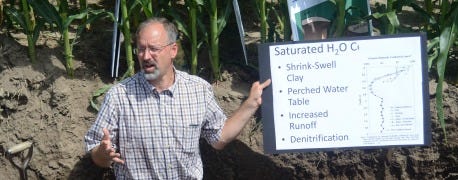
More than 20,000 years ago, glaciers made their way across northern Missouri, sculpting the landscape and depositing glacial till – a mixture of clay and small pebbles. When they eventually broke apart and melted, they left behind silt, which was caught by the wind, turning it into loess, and deposited on top of the clay layer of glacial till across northern Missouri.

SHORING UP THE SOIL: "Growing cover crops isn't a plant and walk away kind of thing," says Brent Myers, University of Missouri plant science assistant professor. But he sees their value for improving clay soil profiles in northern Missouri.
Over time, much of this loess has been chemically weathered into clay, and has merged with the clay layer of glacial till, says Brent Myers, University of Missouri plant science assistant professor. "Where loess isn't very thick, those clays tend to come together and merge," Myers says. "Whether it's the clay layer of the till, or the clay that's formed in the loess material, that topsoil gets eroded away and those clays are brought near the surface, mixed in the surface, and cause lots of problems."
Problems with denitrification
These heavy clay materials absorb water, but don't release it very well. "In winter months when the profile is hydrated, the pores in the clay are squished together, and there's very little movement of water or nitrogen through the soil," Myers says. "If nitrogen is applied in fall or pre-plant, it's at risk to the saturated conditions that happen because water can't move through the clay. That's what leads to the denitrification process."
Soil microbes require oxygen to break down organic matter in the oxidization process. However, if the pores in the soil profile are filled with water, there isn't much room left for oxygen. Instead, the microbes absorb oxygen from nitrate molecules, taking it away from the crop, eventually releasing it as gas to the atmosphere. "That's why nitrogen management is more important in this landscape than any other landscape."
Management decisions
This means taking nitrogen and water into consideration when making cover crop decisions. Cover crops have potential to reduce erosion and improve soil porosity, especially in northern Missouri, but Myers notes they will take the right management.
Cover crops soak up water. So, in a saturated clay environment, they can reduce the likelihood of denitrification. However, killing the cover crop too early leaves more residue for the microbes to break down and no crop to soak up water. "Then you're planting your crop into a pretty wet soil profile with more potential for denitrification and maybe some consequences for the early season health of the crop."
In a drought year, killing cover off too late can result in too much moisture being used up. "That happened in 2011, when cover crops were really starting to take off," Myers says. "People were planting them and if they let them go too far, there wasn't a lot of moisture the rest of the growing season."
Cover crop potential
The kind of cover planted is another factor. Legumes like crimson clover break down more rapidly because of a lower carbon to nitrogen ratio, making the nitrogen more readily available to the following crop. On the other hand, cereal cover crops use a lot of nitrogen, and decay more slowly. This delays the availability of nitrogen to following crops. While this may be positive, avoiding loss from denitrification, it could also tie up nitrogen, making it inaccessible to the crop.
Cover crop management won't be simple, but Myers notes because of the challenges the northern Missouri landscape faces with degraded soils, it is a prime candidate for cover crop systems. "I don't think it's unreasonable to say five to seven inches of topsoil has been lost across northern Missouri as an average," he says. "Growing cover crops isn't a plant and walk away kind of thing, but it potentially has a great value, especially to the northern Missouri landscape."
About the Author(s)
You May Also Like






